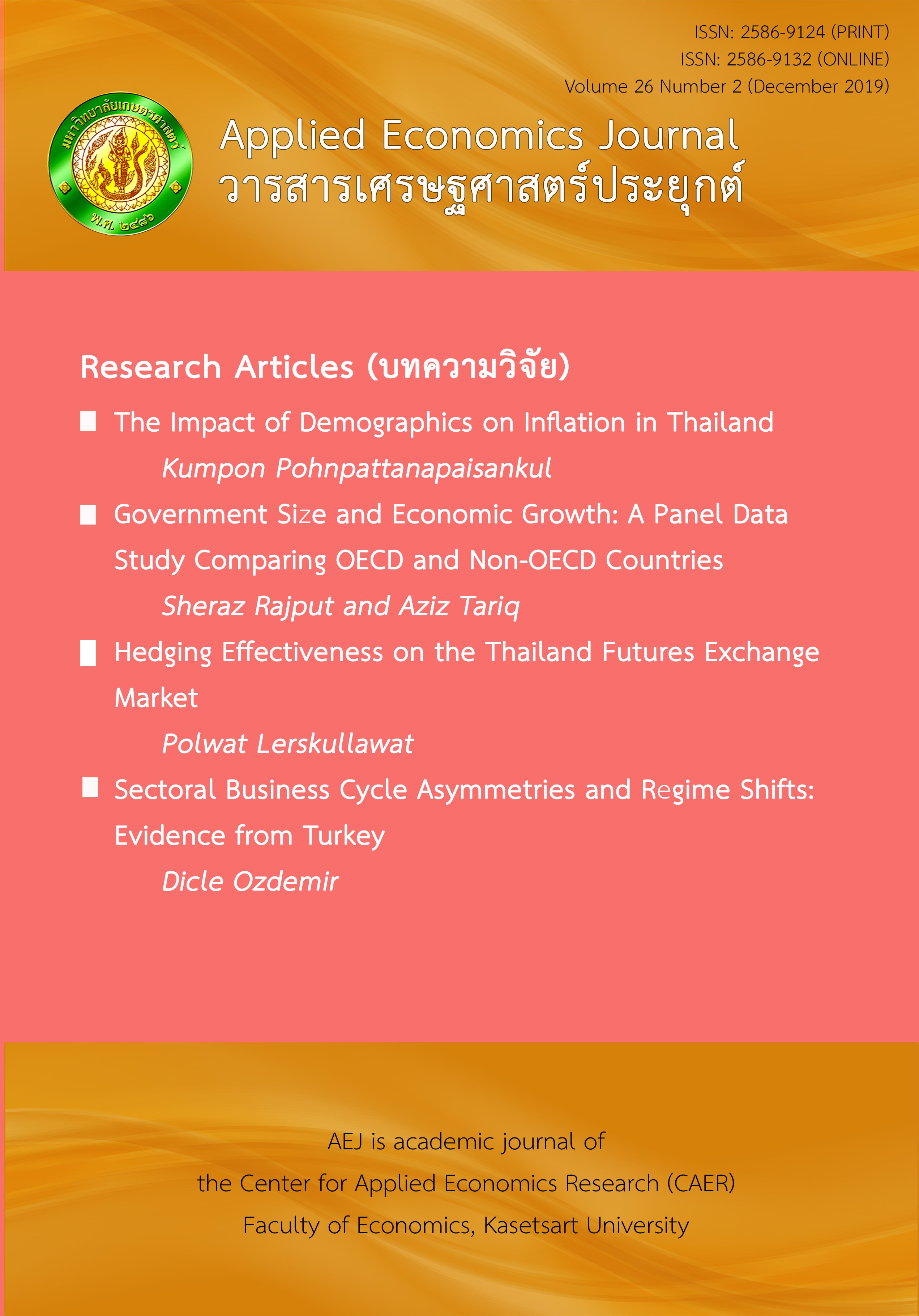The Impact of Demographics on Inflation in Thailand
Main Article Content
Abstract
Recently, Thailand has simultaneously experienced low inflation rate and aging population. Is there a linkage between these two variables as questioned by policy makers and researchers in many countries? The lower working age population and a higher aged people ratio could theoretically change economic agent’s behaviors such as consumption, saving, and others affecting to the macro-level economy and inflation pressures. This paper, hence, tries to find the impact of demographic change on inflation in Thailand from an empirical view. Based on the overall CPI basket and its subcomponents over the sample period 2001 to 2016, the results show that, in general, a declining Thai working age population has a significant deflationary impact. In contrast, in the case of housing and furnishing inflation, the results suggest an inflationary pressure. The findings support the view that demographics are one of the structural factors that alter the economic contexts and have implications on macroeconomic policies in Thailand.
Article Details
The paper is published under CC BY-NC-ND, in which the article is freely downloaded and shared in its original form non-commercially and its citation details are identified.
References
Anderson, D., Botman, D., & Hunt, B. (2014). Is Japan’s population aging deflationary? (IMF Working Paper No. 14/139). Washington, DC: International Monetary Fund.
Azarnert, L. (2005). Child mortality, fertility, and human capital accumulation. Journal of Population Economics, 19(2), 285-297.
Bank of Thailand (2017). Monetary policy report March 2017. Retrieved from https://www.bot.or.th/English/MonetaryPolicy/MonetPolicyComittee/MPR/Pages/default.aspx
Bobeica, E., Lis, E., Nickel, C., & Sun, Y. (2017). Demographics and inflation (ECB Working Paper No. 2006). Frarkfurt: European Central Bank.
Boucekkine, R., Croix, D., & Licandro, O. (2003). Early mortality declines at the dawn of modern growth. Scandinavian Journal of Economics, 105(3), 401-418.
Bullard, J., Garriga, C., & Waller, C.J. (2012). Demographics, redistribution, and optimal inflation, Federal Reserve Bank of St. Louis Review, November/December 2012, 94(6), 419-439.
Cashell, B. (2010). A separate consumer price index for the elderly (Congressional Research Service No. RS20060). Washington, DC: Congressional Research Service.
Choi, W. et al. (2014). Demographic waves, growth potential, and policy options. Paper presented at the 2014 Bank of Korea International Conference, Seoul.
Economic Intelligence Center. (2015). Insight: Staying ahead of Thailand’s graying society report. Retrieved from https://www.scbeic.com/en/detail/file/product/1376/e4fr6fh4pb/EIC_ENG_aging_Q2_2015.pdf
Horioka, C. (2009). Past and future trends in Japan’s household saving rate and the implications thereof for Japan’s current account balance. Paper presented at the conference on Trade and Industry in Asia Pacific, The Australian National University, Canberra.
International Monetary Fund (IMF) (2014). World Economic Outlook. Retrieved from http://www.imf.org/external/pubs/ft/weo/2014/01/.
Juselius, M., & Takats, E. (2015). Can demography affect inflation and monetary policy? (BIS Working Papers No 485). Basel: Bank for International Settlements.
Kashiwase, K., Nozaki, M., & Saito, I. (2014). Health spending in Japan: Macro-fiscal implications and reform options (IMF Working Paper No. 14/142). Washington, DC: International Monetory Fund.
Katagiri, M., Konishi, H., & Ueda, K. (2014). Aging and deflation from a fiscal perspective (WINPEC Working Paper Series No. E1413). Tokyo: Waseda Institute of Political Economy.
Lee, S. H., & Mason, A. (2007). Who gains from the demographic dividend? Forecasting income by age. International Journal of Forecasting, 23(4), 603-619.
Liu, Y., & Westelius, N. (2016). The impact of demographics on productivity and inflation in Japan (IMF Working Paper No. 16/37). Washigton, DC: International Monetary Fund.
Manopimoke, P., & Direkudomsak, W. (2015). Thai inflation dynamics in a globalized economy. Paper presented at the Bank of Thailand Symposium 2015, Centara Grand at Central World, Bangkok.
Peng, X. (2008). Demographic shift, population ageing and economic growth in China: A computable general equilibrium analysis. Pacific Economic Review, 13(5), 680-697.
Pornpattanapaisankul, K. (2010). Monetary policy rule under an inflation targeting framework: Evidence from Thailand. Thammasat Economic Journal, 28(3), 143-179.
World Bank. (2016). Live long and prosper: Aging in East Asia and Pacific. Retrieved from http://pubdocs.worldbank.org/en/165351470911396346/Live-Long-and-Prosper.pdf
World Health Organization (WHO) (2015). The Kingdom of Thailand health system review. Manila: WHO Regional office for the Western Pacific.
Yoon, J., Kim, J., & Lee, J. (2014). Impact of demographic changes on inflation and the macroeconomy (IMF Working Paper No. 14/210). Washington, DC: International Monetary Fund.


